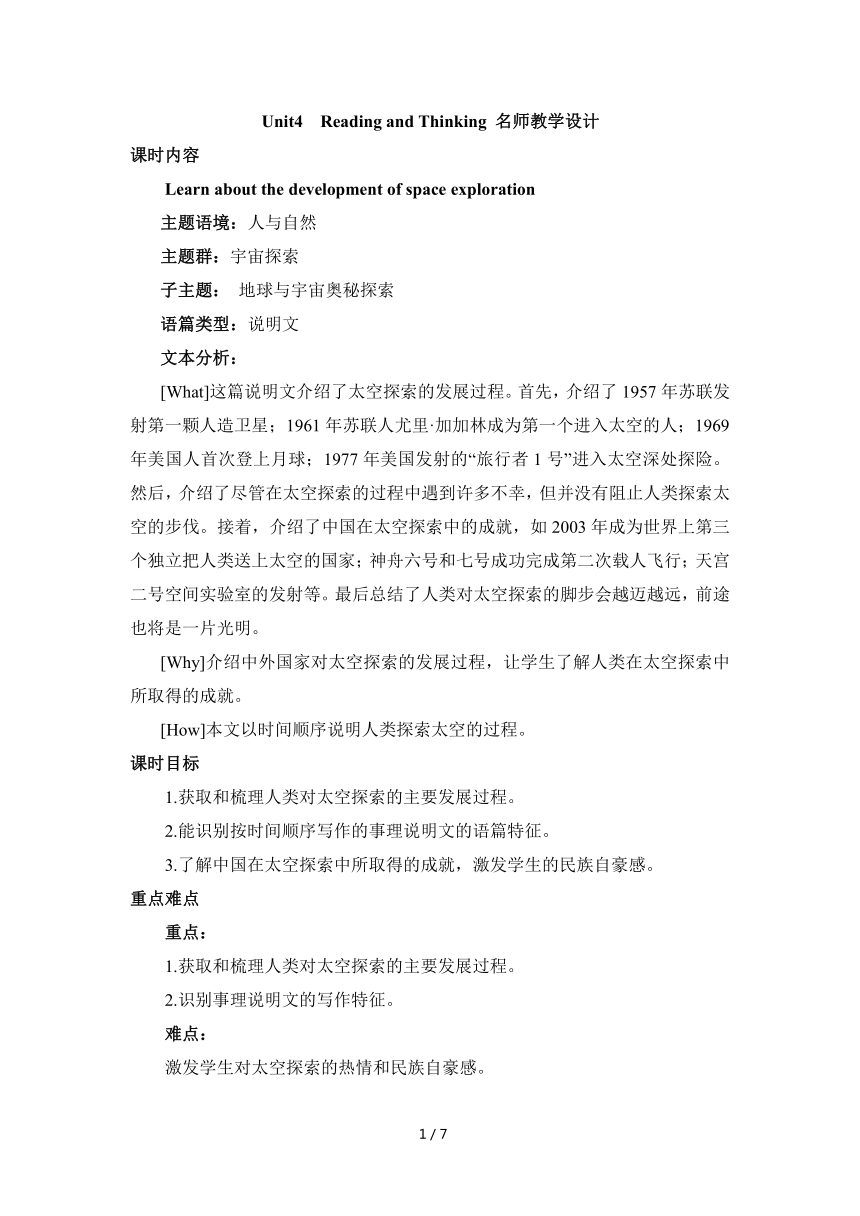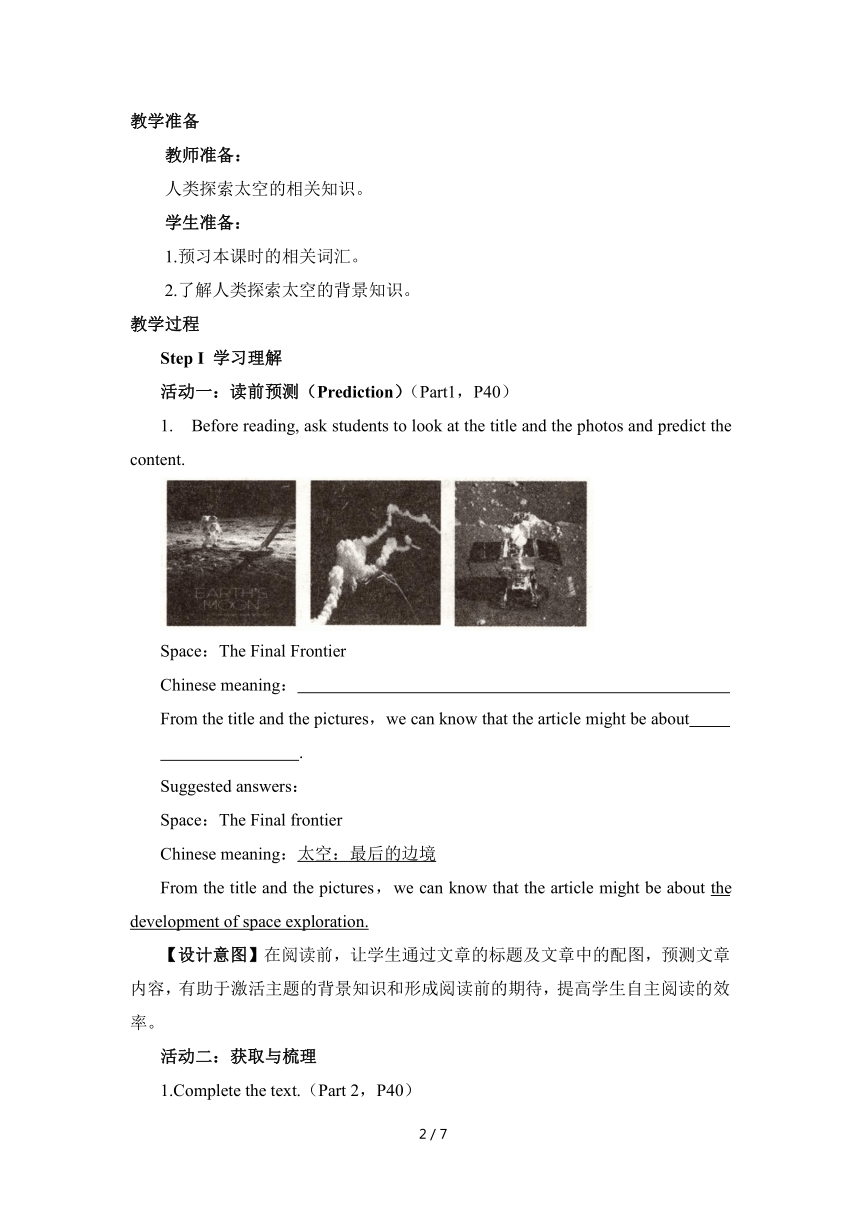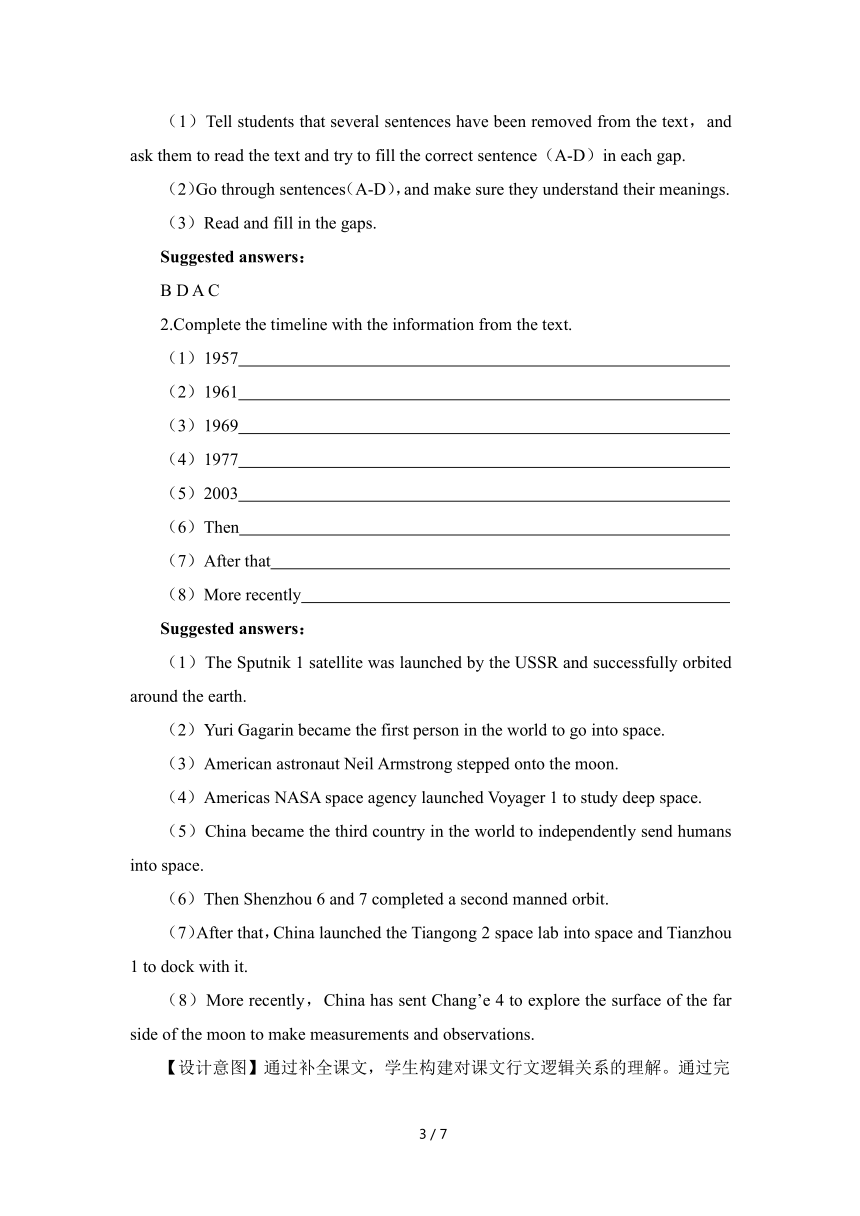人教版(2019)必修第三册 Unit4 Space Exploration Reading and Thinking名师教学设计
文档属性
| 名称 | 人教版(2019)必修第三册 Unit4 Space Exploration Reading and Thinking名师教学设计 |  | |
| 格式 | docx | ||
| 文件大小 | 394.0KB | ||
| 资源类型 | 教案 | ||
| 版本资源 | 人教版(2019) | ||
| 科目 | 英语 | ||
| 更新时间 | 2023-03-10 20:06:35 | ||
图片预览



文档简介
Unit4 Reading and Thinking 名师教学设计
课时内容
Learn about the development of space exploration
主题语境:人与自然
主题群:宇宙探索
子主题: 地球与宇宙奥秘探索
语篇类型:说明文
文本分析:
[What]这篇说明文介绍了太空探索的发展过程。首先,介绍了1957年苏联发射第一颗人造卫星;1961年苏联人尤里·加加林成为第一个进入太空的人;1969年美国人首次登上月球;1977年美国发射的“旅行者1号”进入太空深处探险。然后,介绍了尽管在太空探索的过程中遇到许多不幸,但并没有阻止人类探索太空的步伐。接着,介绍了中国在太空探索中的成就,如2003年成为世界上第三个独立把人类送上太空的国家;神舟六号和七号成功完成第二次载人飞行;天宫二号空间实验室的发射等。最后总结了人类对太空探索的脚步会越迈越远,前途也将是一片光明。
[Why]介绍中外国家对太空探索的发展过程,让学生了解人类在太空探索中所取得的成就。
[How]本文以时间顺序说明人类探索太空的过程。
课时目标
1.获取和梳理人类对太空探索的主要发展过程。
2.能识别按时间顺序写作的事理说明文的语篇特征。
3.了解中国在太空探索中所取得的成就,激发学生的民族自豪感。
重点难点
重点:
1.获取和梳理人类对太空探索的主要发展过程。
2.识别事理说明文的写作特征。
难点:
激发学生对太空探索的热情和民族自豪感。
教学准备
教师准备:
人类探索太空的相关知识。
学生准备:
1.预习本课时的相关词汇。
2.了解人类探索太空的背景知识。
教学过程
Step I 学习理解
活动一:读前预测(Prediction)(Part1,P40)
1. Before reading, ask students to look at the title and the photos and predict the content.
Space:The Final Frontier
Chinese meaning:
From the title and the pictures,we can know that the article might be about
.
Suggested answers:
Space:The Final frontier
Chinese meaning:太空:最后的边境
From the title and the pictures,we can know that the article might be about the development of space exploration.
【设计意图】在阅读前,让学生通过文章的标题及文章中的配图,预测文章内容,有助于激活主题的背景知识和形成阅读前的期待,提高学生自主阅读的效率。
活动二:获取与梳理
1.Complete the text.(Part 2,P40)
(1)Tell students that several sentences have been removed from the text,and ask them to read the text and try to fill the correct sentence(A-D)in each gap.
(2)Go through sentences(A-D),and make sure they understand their meanings.
(3)Read and fill in the gaps.
Suggested answers:
B D A C
2.Complete the timeline with the information from the text.
(1)1957
(2)1961
(3)1969
(4)1977
(5)2003
(6)Then
(7)After that
(8)More recently
Suggested answers:
(1)The Sputnik 1 satellite was launched by the USSR and successfully orbited around the earth.
(2)Yuri Gagarin became the first person in the world to go into space.
(3)American astronaut Neil Armstrong stepped onto the moon.
(4)Americas NASA space agency launched Voyager 1 to study deep space.
(5)China became the third country in the world to independently send humans into space.
(6)Then Shenzhou 6 and 7 completed a second manned orbit.
(7)After that,China launched the Tiangong 2 space lab into space and Tianzhou 1 to dock with it.
(8)More recently,China has sent Chang’e 4 to explore the surface of the far side of the moon to make measurements and observations.
【设计意图】通过补全课文,学生构建对课文行文逻辑关系的理解。通过完成时间表,学生梳理出人类探索宇宙的发展过程和关键事实信息,增强学生对主题内容的认识。
活动三:概括与整合(Make a summary)(Part3,P41)
Ask students to read the text and try to summarise the main idea for each paragraph.
Paragraph 1:
Paragraph 2:
Paragraph 3:
Paragraph 4:
Paragraph 5:
Suggested answers:
Paragraph 1:Humans have always had a natural curiosity about space.
Paragraph 2:Space travel became a reality in the 20th century,with American and Soviet space missions.
Paragraph 3:Space travel has always involved great risk,but despite the risks exploration continues.
Paragraph 4:China has made great progress in space exploration in the early 21st century,becoming only the third country to send humans to space.
Paragraph 5:The future of space exploration looks bright,as many countries are planning further missions.
【设计意图】在对文章内容理解的基础上,学生根据自己的认识,用自己的语言概括出段落大意,有助于提高学生分析和概括的能力,培养学生逻辑思维理解能力。
Step Ⅱ 应用实践
活动四:内化与运用(Focus on language)
1.Complete(Part 5,P41)
Ask students to complete the passage with words from the text.
M is exploring space in the hope of finding out more about the
u . However, exploring space is both dangerous and challenging. One of the most dangerous parts of space exploration is helping people to escape Earth’s g .If there is a mistake during the l ,it can lead to an accident that kills everyone on b .Getting out of o and back to earth’s surface is also very dangerous. Despite the huge risks though, people will always continue to explore this final f so as to learn its secrets.
Suggested answers:
Mankind; universe; gravity; launch; board; orbit ;frontier
2. Retell.
People have always wanted to learn more about space Before the mid-20th century, most people felt (1) (travel) into space was an impossible dream. However,
(2) the help of scientists, people succeeded in realising their dream(3)
(explore) space. On 4 October 1957, the Sputnik 1 satellite (4) (launch) by the USSR.(5) scientists try to be sure nothing goes wrong, accidents can still happen. These disasters made everyone(6) (disappoint),but people still believe in the importance of (7) (carry) on space exploration. In 2003, China became the third country to (8) (independent) send humans into space. Then Shenzhou 6 and 7 completed (9) second manned orbit and the first Chinese spacewalk. In spite of the difficulties, scientists hope future(10) (discovery)will not only enable us to understand the universe but also help us survive well into the future.
Suggested answers:
(1)travelling(2)with(3)to explore(4)was launched(5)Although(6)disappointed(7)carrying(8)independently(9)a(10)discoveries
【设计意图】本环节围绕语言知识学习设计了两个练习,一是让学生使用课本所学单词在语境中填空;一是语段语法填空。在练习语言的同时无形中引导学生阅读了更多同主题语篇。
StepⅢ 迁移创新
活动五:推理与论证(Critical thinking)
Ask students to work in groups and discuss the following two questions:
(1)What do you think of the space exploration?
(2)If you are determined to be an astronaut,what should you prepare at present?
Suggested answers:
(1)I think it is beneficial to us. Through further study of space,people will make full use of it in the future,such as the space experiments by Wang Yaping in Tiangong 1.
(2)First of all,I should study hard to get a related college degree. Besides,I must keep mental and physical healthy.
活动六:批判与评价(Your opinions)(Part4,P41)
Ask students to work in groups and discuss the question:
What does the title“Space The Final Frontier”mean to them?
And share their ideas with the whole class.
【设计意图】该活动培养了学生的发散思维,通过对文本信息的梳理、概括、整合,建构有关单元主题的新概念;让学生表达对文章标题含义的理解,启迪学生思维,有助于多元思维意识的形成和创新思维能力的提高。
板书设计
Unit 4 Space Exploration
Period Ⅱ Reading and Thinking
I.学习理解
活动一:读前预测
活动二:获取与梳理
1.Complete the text
2.Complete the timeline
活动三:概括与整合
Ⅱ.应用实践
活动四:内化与运用
1.Complete
2.Retell
Ⅲ.迁移创新
活动五:推理与论证
活动六:批判与评价
课时内容
Learn about the development of space exploration
主题语境:人与自然
主题群:宇宙探索
子主题: 地球与宇宙奥秘探索
语篇类型:说明文
文本分析:
[What]这篇说明文介绍了太空探索的发展过程。首先,介绍了1957年苏联发射第一颗人造卫星;1961年苏联人尤里·加加林成为第一个进入太空的人;1969年美国人首次登上月球;1977年美国发射的“旅行者1号”进入太空深处探险。然后,介绍了尽管在太空探索的过程中遇到许多不幸,但并没有阻止人类探索太空的步伐。接着,介绍了中国在太空探索中的成就,如2003年成为世界上第三个独立把人类送上太空的国家;神舟六号和七号成功完成第二次载人飞行;天宫二号空间实验室的发射等。最后总结了人类对太空探索的脚步会越迈越远,前途也将是一片光明。
[Why]介绍中外国家对太空探索的发展过程,让学生了解人类在太空探索中所取得的成就。
[How]本文以时间顺序说明人类探索太空的过程。
课时目标
1.获取和梳理人类对太空探索的主要发展过程。
2.能识别按时间顺序写作的事理说明文的语篇特征。
3.了解中国在太空探索中所取得的成就,激发学生的民族自豪感。
重点难点
重点:
1.获取和梳理人类对太空探索的主要发展过程。
2.识别事理说明文的写作特征。
难点:
激发学生对太空探索的热情和民族自豪感。
教学准备
教师准备:
人类探索太空的相关知识。
学生准备:
1.预习本课时的相关词汇。
2.了解人类探索太空的背景知识。
教学过程
Step I 学习理解
活动一:读前预测(Prediction)(Part1,P40)
1. Before reading, ask students to look at the title and the photos and predict the content.
Space:The Final Frontier
Chinese meaning:
From the title and the pictures,we can know that the article might be about
.
Suggested answers:
Space:The Final frontier
Chinese meaning:太空:最后的边境
From the title and the pictures,we can know that the article might be about the development of space exploration.
【设计意图】在阅读前,让学生通过文章的标题及文章中的配图,预测文章内容,有助于激活主题的背景知识和形成阅读前的期待,提高学生自主阅读的效率。
活动二:获取与梳理
1.Complete the text.(Part 2,P40)
(1)Tell students that several sentences have been removed from the text,and ask them to read the text and try to fill the correct sentence(A-D)in each gap.
(2)Go through sentences(A-D),and make sure they understand their meanings.
(3)Read and fill in the gaps.
Suggested answers:
B D A C
2.Complete the timeline with the information from the text.
(1)1957
(2)1961
(3)1969
(4)1977
(5)2003
(6)Then
(7)After that
(8)More recently
Suggested answers:
(1)The Sputnik 1 satellite was launched by the USSR and successfully orbited around the earth.
(2)Yuri Gagarin became the first person in the world to go into space.
(3)American astronaut Neil Armstrong stepped onto the moon.
(4)Americas NASA space agency launched Voyager 1 to study deep space.
(5)China became the third country in the world to independently send humans into space.
(6)Then Shenzhou 6 and 7 completed a second manned orbit.
(7)After that,China launched the Tiangong 2 space lab into space and Tianzhou 1 to dock with it.
(8)More recently,China has sent Chang’e 4 to explore the surface of the far side of the moon to make measurements and observations.
【设计意图】通过补全课文,学生构建对课文行文逻辑关系的理解。通过完成时间表,学生梳理出人类探索宇宙的发展过程和关键事实信息,增强学生对主题内容的认识。
活动三:概括与整合(Make a summary)(Part3,P41)
Ask students to read the text and try to summarise the main idea for each paragraph.
Paragraph 1:
Paragraph 2:
Paragraph 3:
Paragraph 4:
Paragraph 5:
Suggested answers:
Paragraph 1:Humans have always had a natural curiosity about space.
Paragraph 2:Space travel became a reality in the 20th century,with American and Soviet space missions.
Paragraph 3:Space travel has always involved great risk,but despite the risks exploration continues.
Paragraph 4:China has made great progress in space exploration in the early 21st century,becoming only the third country to send humans to space.
Paragraph 5:The future of space exploration looks bright,as many countries are planning further missions.
【设计意图】在对文章内容理解的基础上,学生根据自己的认识,用自己的语言概括出段落大意,有助于提高学生分析和概括的能力,培养学生逻辑思维理解能力。
Step Ⅱ 应用实践
活动四:内化与运用(Focus on language)
1.Complete(Part 5,P41)
Ask students to complete the passage with words from the text.
M is exploring space in the hope of finding out more about the
u . However, exploring space is both dangerous and challenging. One of the most dangerous parts of space exploration is helping people to escape Earth’s g .If there is a mistake during the l ,it can lead to an accident that kills everyone on b .Getting out of o and back to earth’s surface is also very dangerous. Despite the huge risks though, people will always continue to explore this final f so as to learn its secrets.
Suggested answers:
Mankind; universe; gravity; launch; board; orbit ;frontier
2. Retell.
People have always wanted to learn more about space Before the mid-20th century, most people felt (1) (travel) into space was an impossible dream. However,
(2) the help of scientists, people succeeded in realising their dream(3)
(explore) space. On 4 October 1957, the Sputnik 1 satellite (4) (launch) by the USSR.(5) scientists try to be sure nothing goes wrong, accidents can still happen. These disasters made everyone(6) (disappoint),but people still believe in the importance of (7) (carry) on space exploration. In 2003, China became the third country to (8) (independent) send humans into space. Then Shenzhou 6 and 7 completed (9) second manned orbit and the first Chinese spacewalk. In spite of the difficulties, scientists hope future(10) (discovery)will not only enable us to understand the universe but also help us survive well into the future.
Suggested answers:
(1)travelling(2)with(3)to explore(4)was launched(5)Although(6)disappointed(7)carrying(8)independently(9)a(10)discoveries
【设计意图】本环节围绕语言知识学习设计了两个练习,一是让学生使用课本所学单词在语境中填空;一是语段语法填空。在练习语言的同时无形中引导学生阅读了更多同主题语篇。
StepⅢ 迁移创新
活动五:推理与论证(Critical thinking)
Ask students to work in groups and discuss the following two questions:
(1)What do you think of the space exploration?
(2)If you are determined to be an astronaut,what should you prepare at present?
Suggested answers:
(1)I think it is beneficial to us. Through further study of space,people will make full use of it in the future,such as the space experiments by Wang Yaping in Tiangong 1.
(2)First of all,I should study hard to get a related college degree. Besides,I must keep mental and physical healthy.
活动六:批判与评价(Your opinions)(Part4,P41)
Ask students to work in groups and discuss the question:
What does the title“Space The Final Frontier”mean to them?
And share their ideas with the whole class.
【设计意图】该活动培养了学生的发散思维,通过对文本信息的梳理、概括、整合,建构有关单元主题的新概念;让学生表达对文章标题含义的理解,启迪学生思维,有助于多元思维意识的形成和创新思维能力的提高。
板书设计
Unit 4 Space Exploration
Period Ⅱ Reading and Thinking
I.学习理解
活动一:读前预测
活动二:获取与梳理
1.Complete the text
2.Complete the timeline
活动三:概括与整合
Ⅱ.应用实践
活动四:内化与运用
1.Complete
2.Retell
Ⅲ.迁移创新
活动五:推理与论证
活动六:批判与评价
